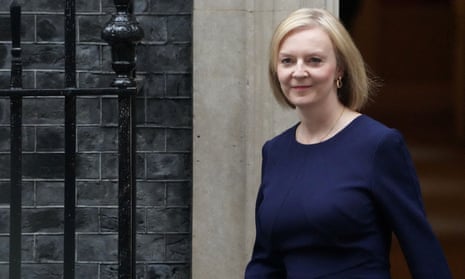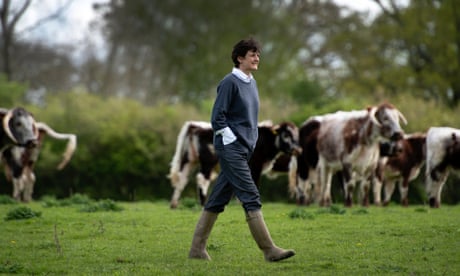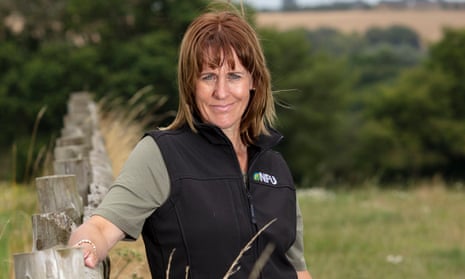‘We are angry’: green groups condemn Truss plans to scrap regulations
Nature protection rules in proposed investment zones would in effect be suspended

Fiona Harvey and Helena Horton
There was little room for doubt about the reaction to the prime minister’s plans to scrap environmental regulations this weekend. “Make no mistake, we are angry. This government has today launched an attack on nature,” tweeted the RSPB, its most forceful political intervention in recent memory.
Liz Truss’s proposals to create investment zones, where green rules on nature protection would in effect be suspended, represented a step too far for some of Britain’s biggest environment charities. “As of today, from Cornwall to Cumbria, Norfolk to Nottingham, wildlife is facing one of the greatest threats it’s faced in decades,” the RSPB went on.
Swiftly after came the Wildlife Trust, representing another million members and also “incredibly angry … at the unprecedented attack on nature”, and the National Trust, with more than 5 million members.
For veteran green campaigners, the strength and speed of the intervention was striking. “It’s a very strong reaction,” said Tom Burke, co-founder of the green thinktank E3G, and a veteran adviser to governments. “The government cannot have been expecting this strong a reaction.”
The list of anti-green policies from a cabinet just a few weeks old is already extensive:
New investment zones threaten a regulatory vacuum where developers can ignore rules on water quality, species conservation and space for nature.
A bonfire of EU regulations could put paid to more than 500 rules protecting the natural world, from wildlife habitats to water quality.
Fracking has been given the green light, and more than 100 new licences for oil and gas drilling will be granted in the North Sea.
A nod to onshore wind was the only low-carbon measure of any note in the “mini-budget” on Friday.
The environmental land management contracts for farmers are being reviewed. Championed as a “Brexit dividend”, Elms were meant to reward farmers for protecting nature, offering “public money for providing public goods”. Scrapping them would return the UK to subsidising intensive agricultural production at the expense of nature.
There has also been little engagement from the cabinet with key stakeholders, including green groups and farming leaders apart from the National Farmers’ Union, a supporter of scrapping Elms. Ranil Jayawardena, the secretary of state for environment, food and rural affairs, has not yet met with green groups and stakeholders, a failure that Shaun Spiers, the executive director of the Green Alliance thinktank, described as “unprecedented”.
The government is still nominally committed to the UK’s legally binding net zero emissions target, and Truss had made senior appointments – including the levelling up secretary, Simon Clarke, and minister Graham Stuart – with green credentials. But green Tories are increasingly concerned.
Ben Goldsmith, the investor and chair of the Conservative Environment Network, said: “There are worrying rumours that the new Conservative ministerial team at Defra are toying with the idea of delaying or derailing the brilliant, groundbreaking new environmental land management scheme, which will link all taxpayer-funded farm payments to the stewardship and restoration of soil and nature. Losing this would of course be a disastrous backwards step, so we must hope that they are only rumours.”
Contrast this with the scene in Liverpool, where Labour opened its party conference this week with the prospect of a clean power generation system by 2030, green public procurement, a low-carbon industrial revolution, and the promise to make Britain “fairer and greener”.
On environmental policy, from fracking to farming, new “clear green water” appears to be opening up between the UK’s two main parties. Spiers warned: “We have been very proud in this country of keeping environmental issues mainstream. This should not be a culture war issue. Conservative voters in middle England don’t want to trash the countryside.”
Despite the furious reaction from mainstream green organisations, which has rattled some backbench and green Tory MPs, Truss seems prepared to double down on her liberalisation agenda even if that means antagonising them further. The Guardian understands that a mooted mollifying statement from No 10, aimed at reassuring voters and MPs in marginal seats, was ditched.
Veteran green experts warned that Truss had misjudged the public mood in her haste to forge a new rightwing radical position. “There is a giant gulf between where Liz Truss thinks the British people are, and where the British people really are,” said Burke.
But he added that green campaigners should not assume that Labour would ride to their rescue. “What parties say in opposition is not always what they do in government. There will need to be firm commitments from Labour that they will restore what the Tories are destroying.”
Doug Parr, policy director of Greenpeace, called on Truss to change course. “[Her] government has launched an indiscriminate attack on environmental rules ignoring both their own manifesto commitments and very strong public concerns about nature,” he warned.

Government poised to scrap nature ‘Brexit bonus’ for farmers
“Voters understand that we need tougher laws to protect the living world. They see water firms getting away with pumping tonnes of raw sewage into our rivers and seas while raking in huge profits, supermarkets flooding our homes with throwaway plastic, and destructive fishing plundering our marine protected areas with impunity. They can tell the difference between so-called red tape and vital rules to stop pollution and environmental harm.”
For Labour, he added, the challenge was to match a strong slate of low-carbon policies with new proposals on nature and the countryside. “This should be a political open goal for Labour. They should get their act together, seize the opportunity and make their nature protection policy as strong as their climate ones.”
Prominent members of farmers’ union express dismay after comments by Minette Batters

Helena Horton
Farmers are threatening to quit the National Farmers’ Union after its leader said she supported the UK government’s apparent move to scrap post-Brexit nature subsidies.
This weekend, the Observer revealed that the government was poised to abandon the “Brexit bonus”, which would have paid farmers and landowners to enhance nature, in what wildlife groups have described as an “all-out attack” on the environment.
Instead of the environmental land management scheme (Elms), Department for Environment, Food and Rural Affairs (Defra) sources disclosed, they are considering paying landowners a yearly set sum for each acre of land they own, which would be similar to the much-maligned EU basic payments scheme of the common agricultural policy.
Minette Batters, the president of the NFU, said she welcomed the departure from Elms. “My absolute priority is ensuring that farmers can continue to produce the nation’s food – so I do support maintaining direct payments in order to build a scheme that really will deliver for food production and the environment,” she said.
She later doubled down on this point, telling the BBC that she believed private money should be used to pay farmers for wildlife recovery, rather than public funds. She said: “We have got literally billions and billions of pounds in green finance that is looking to invest in wild environments. We should be making the private sector work effectively.”
Prominent members of the NFU have spoken to the Guardian, saying they were minded to quit if the leadership failed to clarify its position and support payments for environmental protections.
Jake Freestone, a regenerative farmer and Worcestershire county chairman for the union, has won awards for his soil quality after practicing nature-friendly farming. While he said he is not yet at the point of quitting, he appeared disappointed with the NFU’s apparent views on Elms.
“We do need to focus on the environment as well as food production and what does worry me is if we are going to throw out a lot of environmental protection on the basis of food security. But we are quite happily farming productively here and also providing good environmental protection – if you don’t have wildlife and pollinators and farmland birds, what do you have?” he said.
“The challenge we have is the NFU have a lot of diversified members with a lot of different interests.”
Martin Lines, the chair of the Nature Friendly Farming Network (NFFN), said many of his fellow farmers were leaving the NFU over its perceived anti-nature stance.
“I know of lots of NFU members who are very unhappy or have already left,” he said. “Unfortunately many farmers are members because they feel there hasn’t been any other farming body in the past that is a voice for farming. I know many farmers who are leaving the NFU and joining organisations like the Country Land and Business Association (CLA), NFFN and others, as the NFU doesn’t represent their views or voice.
“Many farmers are starting to realise the NFU does not represent or champion their voice or farming system.”
Mark Tufnell, the chair of the CLA, which represents 30,000 landowners, said he hoped the government would stick with Elms. He said: “There is concern that there might be a change in direction, it’s harsh to come in at a very early stage and say it isn’t working as it hasn’t been given a chance.”
On the NFU’s policy, he said: “You would have to ask the NFU. We have actively stated since about 2017 that we have always felt it is very difficult to justify a flat-rate payment to farmers and landowners just for the sake of owning land. The benefit of Elms is the more public goods you provide, the more you get paid, and you can stack the amounts you do in the public scheme with the private element.”
The NFU has been lobbied by some influential voices who are against Elms. Celebrities including the TV presenter Jeremy Clarkson, former Undertones singer Feargal Sharkey and former cricketers Ian Botham and David Gower have written to the government asking them to scrap environmental regulations.
Writing as “rural voices” who do “real work” that includes “cultivating the soil, looking after sick animals and bringing in the harvest”, they said environmental regulations on farmers “seek to appease the insatiable demands of a few self-righteous campaigners”.
On Monday, Batters said: “We’re pleased the government is reviewing the framework for future farming regulation to help ensure farm businesses are supported through the current economic challenges and can make progressive decisions to boost growth and farming’s contribution to the nation.
“The NFU has always supported the ‘public money for public goods’ policy but we have called for a delay as the scheme was not fit for purpose and ready to roll out in its current form.”

Phillip Inman
Sat 24 Sep 2022
The Observer
The humble concrete mixer will be elevated to exalted status. There will be more executive homes built on greenfield sites. More distribution sheds dotted along busy A-roads. And more urban renewal of the kind that involves tearing down buildings in a plume of dust and carbon emissions to replace them with something not much better, at least not in environmental terms.
At no point in the chancellor’s speech on Friday did he mention the need to reach net zero, or how his plans would help our ailing planet while doling out billions of pounds in tax cuts to richer households and businesses.
Boris Johnson’s administration at least put in place plans for achieving net zero, and Michael Gove considered ways of reversing 70 or more years of severe biodiversity loss.
As Fiona Harvey has documented in the Guardian, Johnson’s premiership brought “more major environmental legislation and arguably greater progress on tackling the climate and nature crises than either of his Conservative predecessors in the past decade”. That’s a low bar when David Cameron and his chancellor George Osborne did their best to kick almost all green initiatives into the long grass, but Johnson did put in place the Agriculture Act, the Fisheries Act, and the Environment Act, coupled with plans to phase out petrol and diesel cars, create a boom in offshore wind, and protect a third of the UK’s land and seas.
Johnson’s legacy, though, is largely rhetoric and very little action. That’s the message from those who attended committee meetings to put meat on the bones of his “10-point plan for a green industrial revolution” only to find themselves in nothing more than a talking shop. One member of Johnson’s Green Jobs Delivery Group, who preferred to remain nameless, said that if the discussion had ever broadened beyond how many millions of trees could be planted in the UK, a strategy might have emerged.
It didn’t seem to matter that senior executives from Siemens, BMW and E.ON were sitting around the table with the head of England’s further education colleges and representatives of the major industrial lobby groups – the discussion still didn’t go anywhere.
By the time Liz Truss sacked the minister in charge who chaired the delivery group, Greg Hands – whose green credentials were burnished when he resigned from a ministerial post in 2018 over plans to expand Heathrow – the group appears to have achieved nothing but an agenda for the next meeting.
Tree planting is indeed an important issue facing urban landscapes, as well as a countryside plagued by drought. Economically, there is also a good reason to talk about the subject: the UK imports 80% of the wood needed for items ranging from toilet paper to construction timber when well-managed forests could fill the gap.
A junior climate minister – well-meaning and well-connected though he is – is clearly only window dressing in a government that wants to bring back fracking
Still, it was one initiative among many, and a change that was poised to spread across major industrial and commercial sectors could not happen while the political focus lay elsewhere.
Green Tories want us to think the party still cares after Truss appointed Graham Stuart as junior minister for climate change. Stuart was one of the leading voices urging Theresa May to enshrine the net zero target in law. He has also been involved in the Globe group of legislators who push for laws mandating climate action to be passed by national parliaments.
But a junior minister – well-meaning and well-connected though he is – is clearly only window dressing in a government that wants to bring back fracking, produce more North Sea oil and rip up planning laws.
Maybe Truss will reveal herself as a champion of green policies: she spoke several times about the need to act on the climate crisis during her leadership campaign and has committed herself to attending Cop27 in Egypt and the 15th biodiversity Cop in Canada.
Except that the new prime minister, as environment secretary, cut subsidies to solar farms. She has also shown little appetite for accelerating an upgrade of the electricity grid to accommodate more renewable energy providers, or supporting major manufacturing industries as they transition to net zero.
Without a prime minister and cabinet that understands the risk of a dash for growth – one that generates yet more carbon – it will fall to fracking protesters and nimbys to prevent the UK going backwards. They will need to be on the streets in force to block what in most cases will be disastrous and unjustified initiatives.















